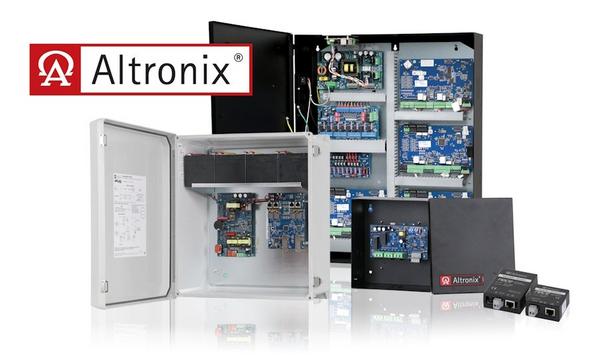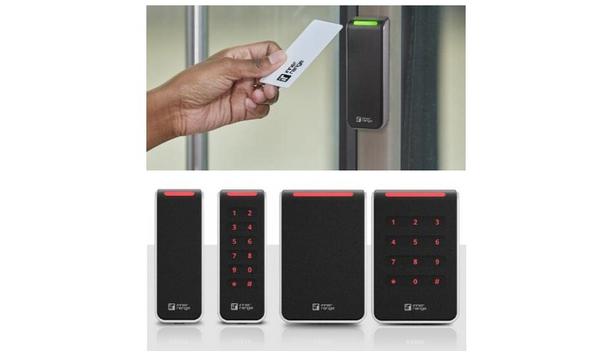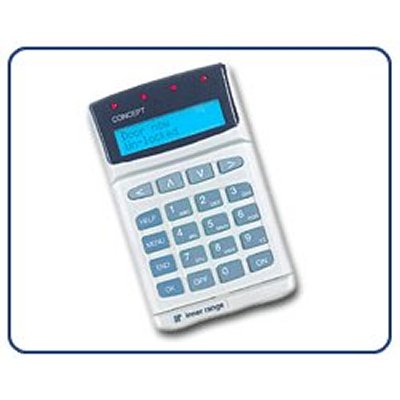Inner Range - Experts & Thought Leaders
Latest Inner Range news & announcements
Altronix, the recognised pioneer in power and data transmission products for the professional security industry, is displaying the company’s latest innovations here at ISC West in booth #11073. Features include integrated power and access control solutions that streamline installation and reduce labour costs, and the latest solutions to deploy IP devices utilising coax, fibre or Ethernet infrastructure. Deployment of advanced IP devices "Altronix continues to deliver new and innovative ways to streamline the deployment of advanced IP devices with greater cost-efficiency, versatility and reliability to ensure heightened security and safety,” said Alan Forman, President of Altronix. “We look forward to demonstrating the numerous advantages and benefits our latest product line-up delivers to our installation partners and customers at ISC West 2025.” New Altronix products on display in booth 11073 Netway Spectrum with EBC48 Integration: The Altronix EBC48 recharges 32AH batteries for NetWay Spectrum models in under eight hours to ensure critical security devices remain operating when there is only intermittent power at the pole. New 277VAC input options now available! Pace™: Advanced technology that extends Ethernet connectivity well beyond traditional limitations, supporting distances up to 1000 metres over a single pair or up to 500 metres over structured cabling, providing an ideal solution for challenging long-distance industrial and IP video applications. Circ™: Advanced multi-path/redundant power solutions ensure seamless transitions between two independent 115VAC or 230VAC inputs, eliminating downtime during power interruptions and power failures, to maintain mission-critical security operations. Trove™ Series: Comprehensive pre-wired, pre-configured access and power kits supporting over 50 pioneering access control brands. including AMAG, AXIS, Azure, Brivo, Hirsch, Mercury, Software House, and TDSi. Easily combine Altronix power with access controllers in scalable wall-mount to extended rack-mount configurations for any installation environment, providing a single point for service and maintenance, minimising wall space. TEMPO724Q: New two-channel network programmable 24/7 timer is designed for diverse applications from security, access control, home automation to lighting control and more. Featuring dual form “C” relay contacts, advanced LINQ™ technology for remote programming and diagnostics, and precise scheduling capabilities, it ensures reliable, synchronised control across complex systems. LINQ™ Network Power Management: Sophisticated remote monitoring platform enabling real-time control and comprehensive reporting of power diagnostics, optimising system performance, preventative maintenance, and overall operational uptime. Altronix Trove™ integration solutions Altronix Trove™ integration solutions will be prominently featured across multiple strategic partner locations throughout the event: Honeywell (LenelS2): Experience Altronix Trove integrated access and power solutions within the comprehensive LenelS2 ecosystem at booth #18059. Inner Range: Discover how Altronix Trove enhances Inner Range's security management systems at booth #25099. Hirsch: Explore access control featuring Altronix Trove access power in wall and rack solutions at booth #13089. PDK: See Altronix's power supply units working with PDK's access control technology at booth #13099. Visit Altronix at ISCW booth #11073 and discover how Altronix power can enhance the security infrastructure.
Wavelynx Technologies, a trailblazer in advanced, secure, and versatile reader and credential solutions, announced the launch of its Middle East and North Africa (MENA) operations, appointing Vishal Khullar, Director of Business Development, as Head of the region. Wavelynx's secure and interoperable access control solutions enable businesses to modernise their authentication technology at a pace that suits their needs. Tailored access control solutions "At Wavelynx, we're committed to providing our customers, including those in the MENA region, with tailored access control solutions," said Rob Lydic, President of Wavelynx Technologies. He adds, "Our advanced technology helps businesses secure their facilities and embrace the opportunities of a digital future." Access in commercial settings These systems play a vital role in enhancing property security and preventing unauthorised access The MENA region is experiencing a surge in demand for access control systems due to growing urbanisation. As cities expand and security concerns rise, access control systems are becoming essential for managing access in commercial settings. These systems play a vital role in enhancing property security and preventing unauthorised access, making them a priority for companies seeking to protect employee safety, data, and assets. Ethos readers, Configure, and Wallet Solution Wavelynx is strategically positioned to deliver advanced access control solutions tailored to the diverse needs of the MENA region’s commercial real estate, hospitality, education, and healthcare sectors. The company’s innovative technologies are designed to enhance security measures, streamline operations, and create safer environments. These include their state-of-the-art Ethos readers, Configure, and the Wavelynx Wallet Solution, which together offer streamlined security management, improved operational efficiency, and a modern approach to access control. Enhancing user experience To deliver tailored solutions that meet the unique needs of the MENA region, Wavelynx is collaborating with partners, including ACRE, AMAG, Genetec, and Tyco/JCI. By leveraging their expertise and market knowledge, Wavelynx is helping clients seamlessly integrate existing systems into the company’s open and secure access control platform, enhancing user experience and reducing operational costs.
HID®, a pioneer in trusted identity solutions announced an extended partnership with its trusted partner Inner Range, a global provider of integrated access control systems and solutions, to offer Inner Range customers a new range of SIFER credentials compatible with wallet-enabled readers, based on HID’s signature line of access control readers, HID Signo®. Mobile access “The sheer opportunity to further deepen collaboration with our partners excites us,” says Steve Katanas, Regional Head for HID Physical Access Control Solutions, ANZ. "Mobile access is rapidly becoming a dominant force in reshaping the physical access security industry and we are glad to be able to extend the mobile access in wallet solution to Inner Range to solidify its position as an integrated access control solutions provider globally." Sustainable, and future-proof identity solutions Katanas adds, “Inner Range customers will get all the benefits of adding mobile credentials in Apple or Google Wallet (and other OEM wallets shortly), designed for the future of the workplace." "I’m excited by the potential of this technology partnership, as we continue to collaborate on future projects, enabled by HID’s secured, sustainable, and future-proof identity solutions.” Encryption and security protocols The in-wallet solution powered by HID Mobile Access provides a pioneering user experience Leveraging HID’s wallet-enabled readers, Inner Range enriches its reader product portfolio, providing its customers an additional choice of adding HID mobile credentials to their wallet, giving employees, tenants, and visitors secure and easy access to office spaces, meeting rooms, printers, lockers and other facilities with a tap of their smartphone or smartwatch near the Inner Range SIFER- enabled readers, powered by HID Signo. The in-wallet solution powered by HID Mobile Access provides a pioneering user experience while employing advanced encryption and security protocols to ensure that access to facilities is both safe and secure. Seamless user experience “We are delighted with the success of our recent collaboration with HID. At Inner Range, providing our customers with a seamless user experience is a core objective for our security solutions,” says Gabriel Daher, VP and GM of Inner Range. "Adding SIFER credential support to the HID Signo reader achieves this perfectly and provides a significant opportunity for Inner Range and our channel by offering future-proof solutions that incorporate both our technologies." Cutting-edge technology Daher adds, “This strategic partnership is a significant milestone that underscores our commitment to leveraging cutting-edge technology to deliver exceptional value to our customers." "We are excited to share this groundbreaking news with our current and prospective clients, confident that it will exceed their expectations. As we continue to strengthen our alliance with HID, we are eager to embark on future projects that promise to harness the full potential of HID technology, with details to be revealed in due course.”
Insights & Opinions from thought leaders at Inner Range
The advantages of security systems as forensic and investigative tools are well understood and demonstrated in the market. However, the new trend is toward systems that are useful in real-time and that even predict a security event, before it happens. We asked this week’s Expert Panel Roundtable: Which security systems are becoming more proactive than reactive?
When designing a security system for a site, the question of how it should be interconnected is often one of the first you need to answer. Should you choose a system that has its own proprietary bus network, which might require twisted pair cabling, or perhaps one based on an ethernet backbone? Both types of network have their advantages and disadvantages as discussed below. Ethernet connectivity Some security systems are based on a number of modules, and each module is connected to its own ethernet connection. One big advantage of a system like this is that, in many cases, it can be much more convenient, allowing the installer to utilise existing network cabling and other infrastructure, rather than needing to install new cabling. On the other hand, if a security system relies entirely on networking infrastructure controlled by others, typically the IT department, then the stability and reliability of the security system is dependent on that network being available when your system needs it. The stability and reliability of the security system is dependent on that network being available Another potential disadvantage is that certain areas of the premises may not be equipped with a nearby network outlet, and if the network in question is not managed by you, it might be necessary to request the IT department add an outlet for you to use. Proprietary bus connectivity A system with its own proprietary bus network can also have advantages. Perhaps the first and most important difference is that, because the network cabling is installed specifically for the security system, the designer has the luxury of being able to decide exactly where the wiring should be placed and terminated. Another advantage is that the cabling would only be used by the security system, so the installation company can be sure the network will always be available, and there would be very little chance part of it could be accidentally unplugged. Another potential advantage is that some systems are able to run bus cabling of distances well over 1,000 metres, whereas individual ethernet connections are typically limited to 100 metres or less. Another consideration, which applies particularly to intruder and holdup alarm systems, is that communications between elements of the security system should not be prevented by other factors, such as a power failure. Obviously, if a part of such a network is formed by ethernet infrastructure, such as network switches and/or media converters, then that infrastructure needs to be battery backed, and the power supply must be monitored. In some cases, the equipment must be able to withstand a power failure of 24 or even 60 hours. Such long standby times are unusual in IT infrastructure, but are quite common in the case of security systems. The equipment must be able to withstand a power failure of 24 or even 60 hours How this all fits together When selecting a system, it is usually most helpful to have a flexible system that can support a number of different deployment options. This is especially true if the system in question can support a combination of different interconnection types. For example, a single system that can contain a variety of interconnections can then be deployed in a very wide variety of systems where existing infrastructure may be used to aid in the design and deployment: Fibre connections – Many modern sites are pre-cabled with existing fibre connections which can be used to form a dedicated interconnection between system components which can be of the order of kilometres apart. Ethernet connectivity – With the increasing ubiquity of networking within premises, some elements of a security system can be deployed using the existing infrastructure. Repeater - For very large or densely packed systems, a device that can be used as a form of “repeater” can be extremely useful to permit very long interconnect cabling distances. Systems can be formed by utilising a fusion of all of the above connectivity methods Some security systems can be set up to enable multiple discrete access control modules to be deployed, connected to an existing ethernet network, and treated as a single ‘system’ by the management software, while retaining full offline functionality in the event the network becomes unavailable. Further, some systems can be formed by utilising a fusion of all of the above connectivity methods. In practice, of course some applications would suit a deployment that relied solely on ethernet connectivity. Some other applications, especially systems or parts of systems that are part of an intruder and/or holdup alarm system, would better suit a deployment using a dedicated proprietary bus network, and other systems would suit a combination of these communications options. Selecting a system that can be deployed in a variety of ways can be enormously helpful in providing the flexibility projects might demand.
Using artificial intelligence (AI) to automate physical security systems
DownloadA modern guide to data loss prevention
Download7 proven solutions for law enforcement key control and asset management
DownloadThe truth behind 9 mobile access myths
DownloadAccess control system planning phase 2
DownloadCONCEPT from inner range - an access, intruder or integrated system with building automation features



























